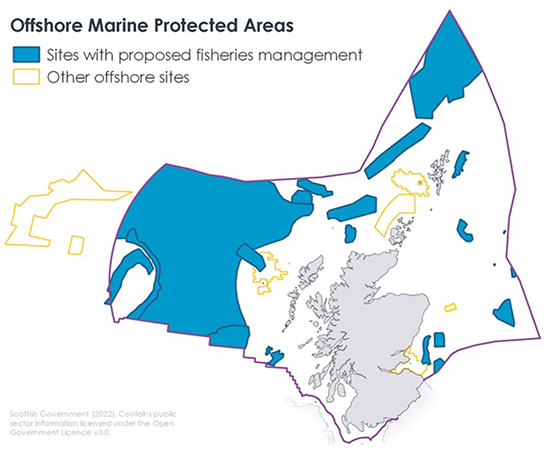Fisheries management measures within Scottish Offshore Marine Protected Areas (MPAs) - Sustainability Appraisal
The Sustainability Appraisal is the overarching document which aims to capture the complexities of the potential socioeconomic and environmental impacts of fisheries management. The Strategic Environmental Assessment and a Socio-Economic Impact Assessment are used the inform the appraisal.
1 Introduction
1.1 Background
The Scottish Government is committed to ensuring the sustainable management of the marine environment by balancing the competing interests of use and protection of the sea. This reflects the vision for the marine environment of “clean, healthy, safe, productive and diverse seas; managed to meet the long term needs of nature and people”[1]. The commitment includes a number of protective designations. These include, amongst others, Nature Conservation Marine Protected Areas[2],[3],[4] (NCMPAs) and Special Areas of Conservation[5],[6] (SACs) (hereafter these MPAs and SACs will be referred to as MPAs when they are being considered collectively). These designations arise from domestic legislation, including legislation that implemented the requirements of European Union (EU) Directives prior to the United Kingdom (UK) leaving the EU, as well as wider UK and international legislation focused on building a cohesive network of protected areas to benefit the conservation of vulnerable and characteristic marine species and habitats.
There are 27 MPAs partially, or wholly within the Scottish offshore region (13 NCMPAs, 11 SACs and 3 Special Protection Areas (SPAs)). Twenty three of these sites have been identified as requiring fisheries management measures for nature conservation purposes. The remaining four sites are considered as requiring no further management due to existing fisheries restrictions, or natural protection. Of the 23 requiring measures, the three SPAs overlap the boundary between inshore and offshore waters and the measures for these sites will be addressed in a separate body of work.
Therefore proposed fisheries management measures have been developed for the remaining 20 offshore MPAs (comprising 10 NCMPAs and 10 SACs) to ensure the site conservation objectives are achieved. Suitable site specific management measures will be implemented at each site, as need be, to conserve the protected features within the protected areas. Scottish Government is now consulting on these proposed measures. The location of these sites are shown in Figure 1.
All 24 sites within the Scottish offshore region have been subject to a Fisheries Assessment to determine the level of impact to the site by fishing activity. Measures for inshore MPAs, for Priority Marine Features (PMFs), and for the three SPAs that overlap the inshore and offshore areas will be considered separately.

The proposed consultation on and implementation of fisheries management measures at the 21 offshore MPAs are the subject of this Sustainability Appraisal (SA), summarising the results of the Strategic Environmental Assessment [7] (SEA) and Socio Economic Impact Assessment [8] (SEIA).
1.2 Sustainability appraisal
The Marine and Coastal Access Act 2009 (Schedule 6 paragraph 10) requires that “a marine plan authority preparing a marine plan must carry out an appraisal of the sustainability of its proposals for inclusion in the plan”. Whilst this applies to the statutory marine planning undertaken through the National Marine Plan process, the proposed fisheries management measures have also been subject to a SA in this instance for consistency in approach and in accordance with Scottish Government practice for projects of this nature.
The SA considers the potential environmental, social and economic effects of the implementation of fisheries management measures at the 21 offshore MPAs drawing on information contained in the SEA7 and SEIA8. It ensures that decision-making is informed by relevant environmental and socio-economic information. The SA also provides opportunities for the public to consider this information and use it to inform their views.
The SEA has been undertaken in line with The Environmental Assessment of Plans and Programmes Regulations 2004 (“the 2004 Regulations”) which require that certain public plans, programmes and strategies be assessed for their potential effects on the environment[9].
The SEIA has been undertaken as a matter of Scottish Government policy. The purpose of the SEIA is to identify and assess the potential economic and social effects of a proposed development or policy on the lives and circumstances of people, their families and their communities. The assessment investigates the potential cumulative economic benefits and costs, and associated potential social impacts, of implementing the proposed management measures at each individual MPA/SAC. It also considers the potential economic benefits and costs, and associated potential social impacts of implementing the suite of measures overall.
The findings from both the SEA and the SEIA have been combined to provide an overall SA of the proposed fisheries management measures for offshore MPAs, to accompany the consultation document. The inputs from the SEA constitute the ‘Environment’ sections of the SA. The inputs from the SEIA inform the ‘Economy and Other Marine Users’ and ‘People, Population and Health’ sections of the SA.
The views of the public, the Consultation Authorities and the Consultation Bodies on the proposed fisheries management measures for offshore MPAs and the findings of this SA Report are now being sought.
The remainder of this report is structured as follows:
- Section 2 provides information on the MPA network to date, the proposed implementation of the fisheries management measures and the policy context;
- Section 3 presents the approach to the SA and the methods used;
- Section 4 sets out the results of the SA; and
- Section 5 considers the next steps.
Contact
Email: marine_biodiversity@gov.scot
There is a problem
Thanks for your feedback